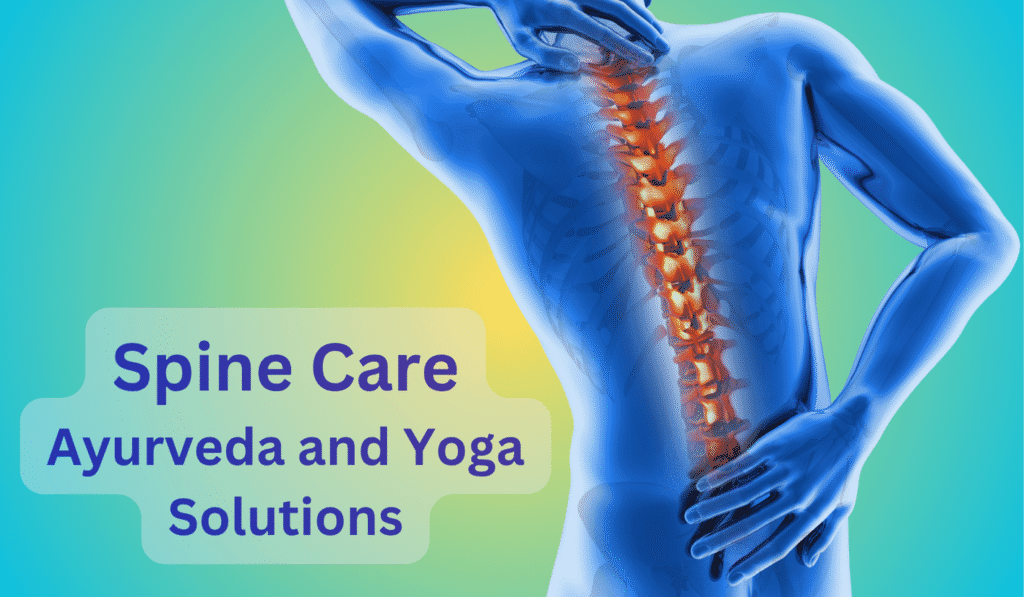Ayurvedic Spine Care: Healing Spondylitis, Disc Issues and Chronic Back Pain
The spine is far more than a structural column; it is the central channel through which the nervous system communicates with every part of the body. Healthy vertebrae, intervertebral discs and supporting muscles ensure that we can move freely, stand upright and protect the delicate spinal cord. Yet disorders of the spine are among the most common causes of chronic pain and disability worldwide. According to the Global Burden of Disease Study, low back pain remains one of the leading contributors to years lived with disability across all age groups.
Common conditions include:
- Cervical and lumbar spondylosis – age-related “wear and tear” of the discs and joints of the neck and lower back, often producing stiffness and persistent discomfort.
- Herniated or prolapsed disc – a rupture or bulge of the soft disc material that can press on adjacent nerves, leading to sharp, radiating pain or even weakness in the limbs.
- Lumbar radiculopathy (sciatica) – irritation or compression of the nerve roots, typically presenting as shooting pain from the lower back down one or both legs.
Key risk factors include natural ageing and disc dehydration; long hours of desk work or heavy lifting; weak core muscles from sedentary habits; and metabolic influences such as obesity or chronic inflammation. Even minor repetitive injuries accelerate degeneration.
Conventional medicine offers effective first-line treatments—from analgesics and anti-inflammatory drugs to physiotherapy and ergonomic corrections. In severe cases, injections or surgery may be recommended. Yet many people find that these measures provide only temporary relief or do not address the deeper cause of recurring pain. This has prompted growing interest in holistic, long-term approaches that not only relieve symptoms but also nourish and strengthen the spine.
How Ayurveda Views Spinal Health
The Central Role of Vata
Among the three doshas—Vata, Pitta and Kapha—Vata governs movement, nerve impulses and the flow of nutrients and waste. The spine and the nervous tissue it protects are considered Vata-dominant. When Vata is aggravated—through chronic stress, irregular routines, excessive travel or the ageing process—it produces qualities of dryness, roughness and instability. These qualities closely resemble the degenerative changes of discs and joints and the erratic nerve firing that leads to pain, tingling or numbness.
Ama, Blocked Channels and Tissue Depletion
Ayurveda also speaks of ama, the toxic residue of incomplete digestion and metabolism. Ama clogs the body’s srotas (micro-channels), preventing proper nutrition of the bones (asthi dhatu) and nervous tissue (majja dhatu). This slow starvation of the structural tissues hastens degeneration. Over time, chronic pain and inflammation deplete ojas, the subtle essence of vitality that underpins immunity and emotional stability.
An Ayurvedic physician therefore assesses not only imaging reports but also the individual’s prakriti (constitution), vikriti (current imbalance), digestive strength (agni) and lifestyle patterns. The aim is to identify the root causes of Vata disturbance and tissue depletion, setting the stage for lasting healing.
Principles of Ayurvedic Management
Purvakarma – Gentle Preparation
Before deeper detoxification, the body is readied through:
- Internal oleation (Snehapana): measured intake of medicated ghee or oils to lubricate internal tissues and loosen toxins.
- External oleation (Abhyanga): full-body massage with warm herbal oils to improve circulation and soften stiff muscles.
- Fomentation (Swedana): mild steam or localized heat to dilate channels and guide toxins toward the gut for elimination.
Panchakarma – Classical Detoxification
Depending on the stage of disease and individual constitution:
- Vasti (medicated enema): the principal therapy for Vata disorders, introducing herbal decoctions and oils into the colon to pacify imbalance and nourish nerve tissue.
- Nasya (nasal therapy): medicated oils through the nostrils to clear the head–neck region and ease cervical stiffness.
- Virechana (therapeutic purgation): when inflammation is prominent, mild purgation clears excess Pitta and inflammatory metabolites.
Localised Therapies for the Spine
Targeted treatments provide direct nourishment and pain relief:
- Kati Vasti or Greeva Vasti: warm medicated oil pooled over the lumbar or cervical spine inside a dough ring to deeply lubricate discs and reduce spasm.
- Kizhi / Pinda Sweda: herbal poultices dipped in warm oil and pressed over affected areas to improve micro-circulation and reduce inflammation.
- Pizhichil: a continuous rhythmic oil bath that lubricates deep tissues and soothes the nervous system.
Rasayana and Brimhana – Rebuilding Vitality
After cleansing, Ayurveda emphasises rejuvenation and tissue rebuilding:
- Rasayana therapy with herbs such as Ashwagandha, Dashamoola or Guggulu to strengthen bones and slow degeneration.
- Brimhana measures—nutrient-rich diet, medicated ghee and tailored lifestyle advice—to rebuild depleted tissues and restore vitality.
This sequence ensures that the body is not only detoxified but also fortified for long-term spinal health.
Yoga and Lifestyle for Spinal Support
Ayurveda and Yoga are sister sciences, and their combination is particularly powerful in spinal care.
- Postural re-education: Gentle asanas such as Bhujangasana (Cobra), Setu Bandhasana (Bridge) and supported twists strengthen the paraspinal muscles and correct alignment.
- Flexibility and circulation: Marjaryasana–Bitilasana (Cat–Cow) and Adho Mukha Svanasana (Downward Dog) improve spinal flexibility and promote nutrient exchange within discs.
- Nervous system regulation: Pranayama (breathing techniques) and Yoga Nidra calm the autonomic nervous system and help manage pain perception.
- Lifestyle corrections: Ergonomic workspaces, movement breaks, balanced anti-inflammatory diet and adequate sleep prevent Vata aggravation.
These self-care practices create a framework for maintaining spine health beyond the treatment centre.
Evidence and Precautions
Modern research is beginning to validate these classical methods. Clinical studies show that Vasti and Abhyanga can reduce pain and improve flexibility in chronic low back pain and spondylitis. Yoga has been widely documented to improve functional capacity and reduce recurrence of back pain episodes.
As with any therapy, individualisation and medical supervision are essential. People with severe neurological deficits or progressive weakness should seek evaluation by qualified professionals. Integrative care—combining necessary imaging, modern diagnostics and Ayurvedic therapy—often yields the safest and most comprehensive results.
Shantitheeram’s Spine Care & Spondylitis Program
For those seeking the best Ayurvedic treatment in Kerala, particularly for complex spinal issues, specialised centres provide the depth of care that home remedies or generic massages cannot. Shantitheeram Ayurveda in Alappuzha—an Ayurveda and yoga retreat in Kerala—offers a dedicated Spine Care & Spondylitis Program that blends classical therapies with modern wellness support.
Key Features
- Comprehensive Consultation: Thorough evaluation of cervical/lumbar spondylitis, disc herniation or sciatica to identify root causes.
- Classical Therapies: Kati Vasti, Greeva Vasti, Pizhichil and targeted Panchakarma like Vasti and Nasya to pacify aggravated Vata.
- Herbal & Rasayana Support: Formulations to strengthen bone and nerve tissues and slow degeneration.
- Yoga Therapy & Pranayama: To improve posture, strengthen core muscles and reduce nervous system overactivity.
- Diet & Lifestyle Guidance: Ongoing support to maintain spinal health beyond your stay.
This program is delivered in a serene, resort-like environment while maintaining the standards of a medical facility — Healing Like a Clinic, Caring Like a Home!
Key Takeaways
Spinal disorders are common and disabling, but long-term healing requires more than symptom control. Ayurveda offers a holistic framework that addresses root causes—Vata imbalance, toxin accumulation and tissue depletion—while modern evidence supports its role in pain reduction and functional improvement.
For individuals seeking a truly integrative path, an Ayurveda and yoga retreat in Kerala, such as Shantitheeram in Alappuzha, provides the environment, expertise and personalised care needed to restore spinal health and sustain it for years to come.

